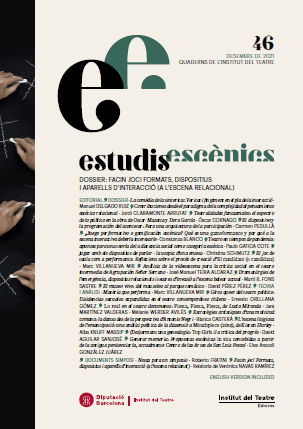El dispositivo y la programación del acontecer: para una arquitectura de la participación
Paraules clau:
dispositivo, participación, espectador, programación, dramaturgia, red, arquitectura, espacio, lenguaje, paradigmaResum
En el contexto teatral europeo contemporáneo, la implicación del espectador como parte integral y decisiva de la realización escénica es una pràctica muy extendida, capaz de redefinir las teorías y las praxis del lenguaje teatral. La contribución material del espectador forma parte intrínseca a la escritura escénica, algunas veces en calidad de co-creador con los actores, otras veces como único creador y protagonista en el escenario.
El siguiente artículo propone una reflexión sobre el concepto y el rol del dispositivo en los espectáculos destinados a la fruición únicamente de los espectadores. El dispositivo, entendido en la concepción de Michel Foucault como - «cruce de relaciones de poder y de saber» - (Agamben, 2006: 7), cambia la escritura dramatúrgica tradicional: el dispositivo prevé la introducción de la actividad de programación en el ámbito escénico. Por consiguiente, el dispositivo constituye la dramaturgia del acontecimiento escénico, con la previsión y la organización del acontecer en cada fase, conciliándolo con la acción del espectador. Utilizando algunos dispositivos tecnológicos (tableta, auriculares, mandos, etc.), el espectador sigue las instrucciones y las preguntas, contribuyendo de esta forma a la realización escénica. En función de las formas del dispositivo, cambia la modalidad de inclusión del espectador en las dinámicas participativas programadas. En algunos casos la forma asumida por el diseño dramatúrgico es la de un complejo diseño con la construcción de una poética sensorial, espacial y del imaginario o con la reescritura de la realidad; en otros, la de la red que origina una arquitectura de la experiencia vivida por el espectador, único protagonista en el escenario.
A partir de estas reflexiones, se examinarán diferentes paradigmas participativos, para analizar cómo estas prevén modalidades específicas de relación: entre el espectador y la performance participativa; entre los espectadores; y entre el espectador consigo mismo. De cada tipología se mostrarán ejemplos específicos, que permitirán establecer una mirada extensa a los lenguajes propios de la participación y a las mutaciones que esta implica en los códigos lingüísticos teatrales.














